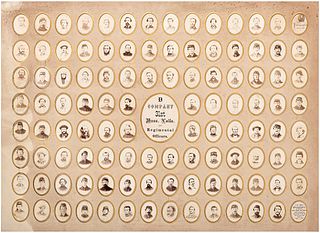
The 1st Independent Battery Wisconsin Light Artillery was an artillery battery from Wisconsin that served in the Union Army during the American Civil War.
The 1st Louisiana Regiment Cavalry was a cavalry unit in the Union Army during the American Civil War. The regiment was one of several organized in New Orleans in August 1862 by order of Maj. Gen. Benjamin F. Butler and recruited from among "white Unionists, and pro-Northern refugees" in the city; it consisted primarily of foreigners and men of Northern birth.
1st Maine Light Artillery Battery was an artillery battery that served in the Union Army during the American Civil War.
Chicago Mercantile Independent Battery Light Artillery was an artillery battery that served in the Union Army during the American Civil War.

1st Regiment Indiana Heavy Artillery was a heavy artillery regiment that served in the Union Army during the American Civil War. It was nicknamed the "Jackass Regiment". Before being converted into an artillery unit in 1863, it served as the 21st Regiment, Indiana Volunteer Infantry.
The 8th New Hampshire Infantry Regiment was an infantry regiment that served in the Union Army during the American Civil War.

The 75th New York Infantry Regiment was an infantry and mounted infantry regiment in the Union Army during the American Civil War.
The 30th Massachusetts was an infantry regiment that served in the Union Army during the American Civil War.

The 31st Massachusetts was an infantry regiment that served in the Union Army during the American Civil War. It was converted into a mounted infantry regiment in December 1863.

The 156th New York Infantry Regiment was an infantry regiment in the Union Army during the American Civil War.
The 175th New York Infantry Regiment was an infantry regiment in the Union Army during the American Civil War.

The 133rd New York Volunteer Infantry was an infantry regiment in the Union Army during the American Civil War.

The 160th New York Infantry Regiment was an infantry regiment in the Union Army during the American Civil War.

The 165th New York Infantry Regiment was an infantry regiment in the Union Army during the American Civil War.
The 173rd New York Infantry Regiment was an infantry regiment in the Union Army during the American Civil War.

The 110th New York Infantry Regiment was an infantry regiment in the Union Army during the American Civil War.

The 131st New York Infantry Regiment was an infantry regiment in the Union Army during the American Civil War.

The 163rd New York Infantry Regiment was an infantry regiment in the Union Army during the American Civil War.

The 6th Massachusetts Battery was an artillery battery that served in the Union Army during the American Civil War. The unit was one of the Massachusetts regiments organized in response to President Abraham Lincoln's call on May 2, 1861 for volunteer troops to serve a term of three-years. The battery trained at Camp Chase in Lowell, Massachusetts. It was assigned to the Department of the Gulf under Major General Benjamin F. Butler and departed Boston by steamship on February 8, 1862. At that time, the unit comprised 145 men armed with two rifled and four smoothbore six-pounder field guns.
1st U.S. Artillery, Battery F was a United States Army field artillery battery that was in service between 1821 and 1901, most notably in extensive service with the Union Army during the American Civil War. In that conflict, the battery was engaged at the battles of Pensacola, Fort Bisland, Vermilion Bayou, Port Hudson, and Mansura.






